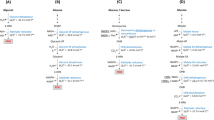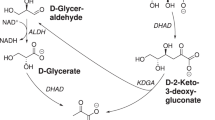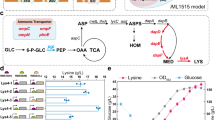Abstract
We report the engineering of Lactococcus lactis to produce the amino acid l-alanine. The primary end product of sugar metabolism in wild-type L. lactis is lactate (homolactic fermentation). The terminal enzymatic reaction (pyruvate + NADH→l-lactate + NAD+) is performed by l-lactate dehydrogenase (l-LDH). We rerouted the carbon flux toward alanine by expressing the Bacillus sphaericus alanine dehydrogenase (l-AlaDH; pyruvate + NADH + NH4+→l-alanine + NAD+ + H2O). Expression of l-AlaDH in an l-LDH-deficient strain permitted production of alanine as the sole end product (homoalanine fermentation). Finally, stereospecific production (>99%) of l-alanine was achieved by disrupting the gene encoding alanine racemase, opening the door to the industrial production of this stereoisomer in food products or bioreactors.
This is a preview of subscription content, access via your institution
Access options
Subscribe to this journal
Receive 12 print issues and online access
$209.00 per year
only $17.42 per issue
Buy this article
- Purchase on Springer Link
- Instant access to full article PDF
Prices may be subject to local taxes which are calculated during checkout






Similar content being viewed by others
References
Leuchtenberger, W. in Products of primary metabolism Vol. 6 (vol. ed. Roehr, M.). Biotechnology (eds Rhem, H.-J., Reed, G., Pühler, A. & Stadler, P.J.W.) 465–502 (VCH Verlagsgesellschaft mbH, Weinheim, Germany; 1996).
Hirose, Y. & Okada, H. in Microbial technology, microbial process (eds Peppler, H.J. & Perlman, D.) 211–240 (Academic, New York; 1979).
Yamamoto, T., Kato, T., Matsuo, R., Kawamura, Y. & Yoshida, M. Gustatory reaction time to various sweeteners in human adults. Physiol. Behav. 35, 411–415 (1985).
Kitai, A. in The microbial production of amino acids (eds Yamada, K., Kinoshita, S., Tsunoda, T. & Aida, K.) 325–337 (Kodansha Ltd, Tokyo, John Wiley and Sons, New York ; 1972).
Ravot, G. et al. l-alanine production from glucose fermentation by hyperthermophilic members of the domains bacteria and archaea: a remnant of an ancestral metabolism? Appl. Environ. Microbiol. 62, 2657–2659 (1996).
Orlygsson, J., Anderson, R. & Svensson, B.H. Alanine as an end product during fermentation of monosaccharides by Clostridium strain P2. Antonie Van Leeuwenhoek 68, 273–280 (1995).
Hashimoto, S.-I. & Katsumata, R. Overproduction of alanine by Arthrobacter strains with glucose-nonrepressible l-alanine dehydrogenase. Biotechnol. Lett. 15, 1117–1122 (1993).
Furui, M. & Yamashita, K. Pressurized reaction method for continious production of l-alanine by immobilized Pseudomonas dacunhae cells. J. Ferment. Technol. 61, 587–591 (1983).
Galkin, A., Kulakova, L., Yoshimura, T., Soda, K. & Esaki, N. Synthesis of optically active amino acids from α-keto acids with Eschericihia coli cells expressing heterologous genes. Appl. Environ. Microbiol. 63, 4651–4656 (1997).
Uhlenbusch, I., Sahm, H. & Sprenger, G.A. Expression of the l-alanine dehydrogenase gene in Zymomonas mobilis and excretion of l-alanine. Appl. Environ. Microbiol. 57, 1360–1366 (1991).
Eikmanns, B., Sham, H. & Sprenger, G. Metabolic design bei Bakterien: gezielte Entwicklung von aminosäureproduzierenden Bakterien mit Hilfe der Gentechnik Bioscope 2/95, 39–45 (1995).
de Vos, W.M. Metabolic engineering of sugar catabolism in lactic acid bacteria. Antonie Van Leeuwenhoek 70, 223–242 (1996).
Ohashima, T. & Soda, K. Purification and properties of alanine dehydrogenase from Bacillus sphaericus. Eur. J. Biochem. 100, 29–39 (1979).
Hillier, A.J. & Jago, G.R. l-lactate dehydrogenase, FDP-activated, from Streptococcus cremoris. Methods Enzymol. 89, 362–367 (1982).
de Ruyter, P.G.G.A., Kuipers, O.P. & de Vos, W.M. Controlled gene expression systems for Lactococcus lactis with the food-grade inducer nisin. Appl. Environ. Microbiol. 62, 3662–3667 (1996).
Kuipers, O.P., de Ruyter, P.G.G.A., Kleerebezem, M. & de Vos, W.M. Controlled overproduction of proteins by lactic acid bacteria. Trends Biotechnol. 15, 135–140 (1997).
Kuroda, S., Tanizawa, K., Sakamoto, Y., Tanaka, H. & Soda, K. Alanine dehydrogenases from two Bacillus species with distinct thermostabilities: molecular cloning, DNA and protein determination and structural comparison with other NAD(P)+-dependent dehydrogenases. Biochemistry 29, 1009–1015 (1990).
Platteeuw, C., Hugenholtz, J., Starrenburg, M., Alen-Boerrigter, I. & de Vos, W.M. Metabolic engineering of Lactococcus lactis: influence of the overproduction of α-acetolactate synthase in strains deficient in lactate dehydrogenase as a function of culture conditions. Appl. Environ. Microbiol. 61, 3967–3971 (1995).
Ferain, T., Schanck, A.N. & Delcour, J. 13C nuclear magnetic resonance analysis of glucose and citrate end products in a ldhL-ldhD double knockout strain of Lactobacillus plantarum. Appl. Environ. Microbiol. 178, 7311–7315 (1996).
Foucaud, C., Herve, M., Neumann, J.M. & Hemme, D. 1995.Glucose metabolism and internal pH of Lactococcus lactis subsp. lactis cells utilizing NMR spectroscopy. Lett. Appl. Microbiol. 21, 10–13 (1995).
Snoep, J.L., de Mattos, M.J.T., Starrenburg, M.J.C. & Hugenholtz, J. Isolation, characterization, and physiological role of the pyruvate dehydrogenase complex and α-acetolactate synthase of Lactococcus lactis subsp. lactis bv. diacetylactis. J. Bacteriol. 174, 4838–4841 (1992).
Mou, L., Sullivan, J.J. & Jago, G.R. Autolysis of Streptococcus cremoris. J. Dairy Res. 43, 275–282 (1976).
Vegarud, G., Castberg, H.B. & Langsrud, T. Autolysis of group N streptococci. Effects of media composition modifications and temperature. J. Dairy Sci. 66, 2294–2302 (1983).
Buist, G. et al. Molecular cloning and nucleotide sequence of the gene encoding the major peptidoglycan hydrolase of lactococcus lactis, a muramidase needed for cell separation. J. Bacteriol. 177, 1554–1563 (1995).
Wasserman, S.A., Daub, E., Grisafi, P., Botstein, D. & Walsh, C.T. Catabolic alanine racemase from Salmonella typhimurium: DNA sequence, enzyme purification and characterization. Biochemistry 23, 5182–5187 (1984).
Wang, E. & Walsh, C. Suicides subtrates for the alanine racemase of Escherichia coli B. Biochemistry 17, 1313–1321 (1978).
Lobocka, M., Henning, J., Wild, J. & Klopotowski, T. Organization and expression of the Escherichia coli K-12 dad operon encoding the smaller subunit of the d-amino acid dehydrogenase and the catabolic alanine racemase. J. Bacteriol. 176, 1500–1510 (1994).
Ferrari, E., Henner, D.J. & Yang, M.Y. Isolation of an alanine gene from Bacillus subtilis and its use for plasmid maintenance in B. subtilis. Bio/Technology 3, 1003–1007 (1985).
Hols, P. et al. The alanine racemase gene is essential for growth of Lactobacillus plantarum. J. Bacteriol. 179, 3804–3807 (1997).
Ohta, K., Beall, D.S., Mejia, J.P., Shanmugan, K.T. & Ingram, L.O. Genetic improvement of Escherichia coli for ethanol production: chromosomal integration of Zymomonas mobilis genes encoding pyruvate decarboxylase and alcohol dehydrogenase II. Appl. Environ. Microbiol. 57, 893–900 (1991).
Ohta, T., Ogbonna, J.C., Tanaka, H. & Yajima, M. Development of a fermentation method using immobilized cells under unsterile conditions. 2. Ethanol and l-lactic acid production without heat and filter sterilization. Appl. Microbiol. Biotechnol. 42, 246–250 (1994).
Casadaban, M.J. & Cohen, S.N. Analysis of gene control signals by DNA fusion cloning in Escherichia coli. J. Mol. Biol. 138, 179–207 (1980).
Sambrook, J., Fritsch, E.F. & Maniatis, T. Molecular cloning: a laboratory manual 2nd edn (Cold Spring Harbor Laboratory, Cold Spring Harbor, NY; 1989).
Vos, P. et al. A maturation protein essential for the production of active forms of Lactococcus lactis SK11 serine proteinase located in or secreted from the cell envelope. J. Bacteriol. 171, 2795–2802 (1989).
Leenhouts, K.J., Kok, J. & Venema, G. Campbell-like integration of heterologous plasmid DNA into the chromosome of Lactococcus lactis subsp. lactis. Appl. Environ. Microbiol. 55, 394–400 (1989).
Wells, J.M., Wilson, P.W. & Le Page, R.W.F. Improved cloning vectors and transformation procedure for Lactococcus lactis. J. Appl. Bacteriol. 74, 629–636 (1993).
Ferain, T., Garmyn, D., Bernard, N., Hols, P. & Delcour, J. Lactobacillus plantarum ldhL gene: overproduction and deletion. J. Bacteriol. 176, 596–601 (1994).
Chen, J.-D. & Morisson, D.A. Construction and properties of a new insertion vector, pJDC9, that is protected by transcriptional terminators and useful for the cloning of DNA from Streptococcus pneumoniae. Gene 64, 155–164 (1988).
Laemmli, U.K. Cleavage of structural proteins during the assembly of the head of bacteriophage T4. Nature 27, 680–685 (1970).
Starrenburg, M.J.C. & Hugenholtz, J. Citrate fermentation by Lactococcus and Leuconostoc spp. Appl. Environ. Microbiol. 57, 3535–3540 (1991).
Acknowledgements
We thank G.A. Sprenger for providing plasmid pBM20alaD; P. Renault for sequence information on the alr gene from L. lactis IL1403 preceding publication; and R. Holleman, H. Kosters, and M. Starrenburg for their technical help in HPLC analyses and fermentation. This research was carried out in the framework of the Community Research Programme BIOTECH (contract no. BIO4-CT96-0498). P.H. holds a fellowship of the EC BIOTECH programme (contract no. BIO4-CT96-5093).
Author information
Authors and Affiliations
Corresponding author
Rights and permissions
About this article
Cite this article
Hols, P., Kleerebezem, M., Schanck, A. et al. Conversion of Lactococcus lactis from homolactic to homoalanine fermentation through metabolic engineering. Nat Biotechnol 17, 588–592 (1999). https://doi.org/10.1038/9902
Received:
Accepted:
Issue Date:
DOI: https://doi.org/10.1038/9902
This article is cited by
-
Alanine dehydrogenases from four different microorganisms: characterization and their application in L-alanine production
Biotechnology for Biofuels and Bioproducts (2023)
-
Pathway construction and metabolic engineering for fermentative production of β-alanine in Escherichia coli
Applied Microbiology and Biotechnology (2020)
-
Heterologous Expression of Aldehyde Dehydrogenase in Lactococcus lactis for Acetaldehyde Detoxification at Low pH
Applied Biochemistry and Biotechnology (2018)
-
A review on Lactococcus lactis: from food to factory
Microbial Cell Factories (2017)
-
GC-MS based metabolomics analysis reveals the effects of different agitation speeds on the level of proteinogenic amino acids in Lactococcus lactis subsp. cremoris MG1363
Annals of Microbiology (2017)



